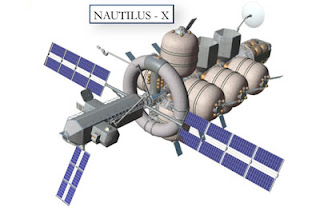Human On The Moon Cheapest
As the first flight of SpaceX's Falcon Heavy in 2014 approaches more information is slowly becoming available. In a recently released NASA study, Wilhite et al revealed an estimate for the mass of the 5.2m wide hammerhead fairing. Combined with the maximum payload to low Earth orbit, it is now apparent that payloads that don't require the fairing could have an initial mass of over 55 tons. This seems sufficient to mount a single person lunar landing (and return) mission with just the one launch.
For simplicity, I will assume a two ton single stage lunar lander with additional drop tanks. I'll use a self-pressurizing mixed monoprop, like NOFBX from Firestar (isp 320s). Starting in LEO the vehicle will perform three burns (3107m/s, 3140m/s, and 2890m/s), not stopping in lunar orbit and dropping tanks after each burn.
Hopefully, SpaceX will kick in some PICA-X for the heat shield, which will be mounted on a Mercury-sized capsule. The lander will look much like the Odyssey/SpaceX/Firestar alternative that was floated during the NASA Altair studies.
The flight will be cramped, uncomfortable and lonely. After landing on the surface, the pilot slips into his suitport to explore the surface. This removes the need for an airlock, saving mass, and exposure of the cabin to vacuum, simplifying the design.
Finally, the pilot will return to Earth, braving a fiery reentry at lunar velocities to land off the coast under a single parachute.
A small boat will retrieve the pilot.
The total cost of the mission will be around $150 million.
For simplicity, I will assume a two ton single stage lunar lander with additional drop tanks. I'll use a self-pressurizing mixed monoprop, like NOFBX from Firestar (isp 320s). Starting in LEO the vehicle will perform three burns (3107m/s, 3140m/s, and 2890m/s), not stopping in lunar orbit and dropping tanks after each burn.
Hopefully, SpaceX will kick in some PICA-X for the heat shield, which will be mounted on a Mercury-sized capsule. The lander will look much like the Odyssey/SpaceX/Firestar alternative that was floated during the NASA Altair studies.
The flight will be cramped, uncomfortable and lonely. After landing on the surface, the pilot slips into his suitport to explore the surface. This removes the need for an airlock, saving mass, and exposure of the cabin to vacuum, simplifying the design.
Finally, the pilot will return to Earth, braving a fiery reentry at lunar velocities to land off the coast under a single parachute.
A small boat will retrieve the pilot.
The total cost of the mission will be around $150 million.






Thanks for that informative post. A ca. 50 mT mass to LEO is that required for the Early Lunar Access (ELA) proposal of the early 90's:
ReplyDeleteEncyclopedia Astronautica
Early Lunar Access.
http://www.astronautix.com/craft/earccess.htm
It uses a somewhat larger 2-man capsule at 3 mT empty weight and all cryogenic in-space propulsion.
The thing is the SLS in its earliest configuration at 70 mT will have the ability to launch this using currently existing Centaur-like in-space stages. I discuss this here:
SLS for Return to the Moon by the 50th Anniversary of Apollo 11.
http://exoscientist.blogspot.com/2012/10/sls-for-return-to-moon-by-50th.html
Bob Clark
What about price? Ya know, the point of this blog post. Centaur is the most expensive rocket stage available.
Delete